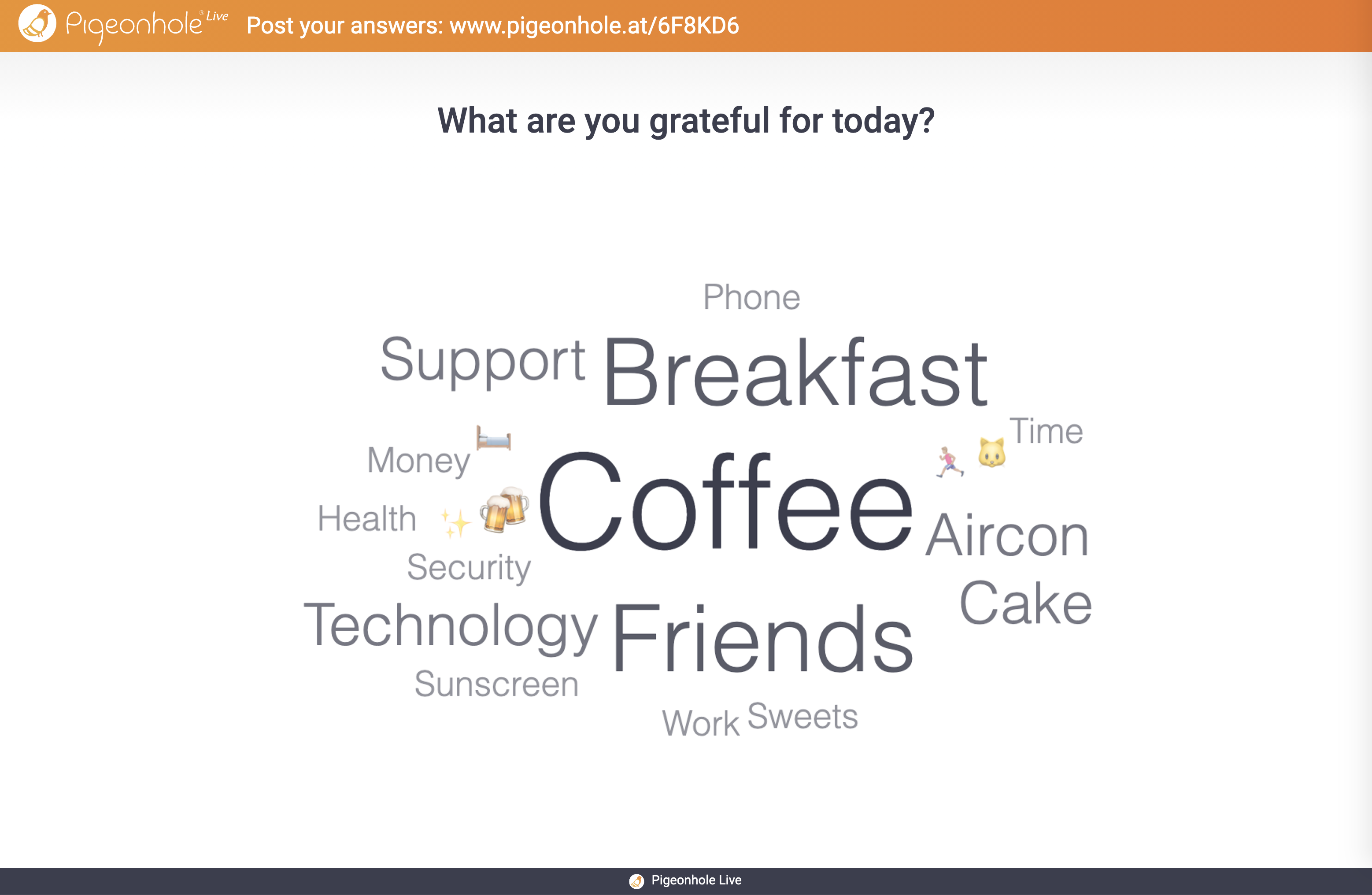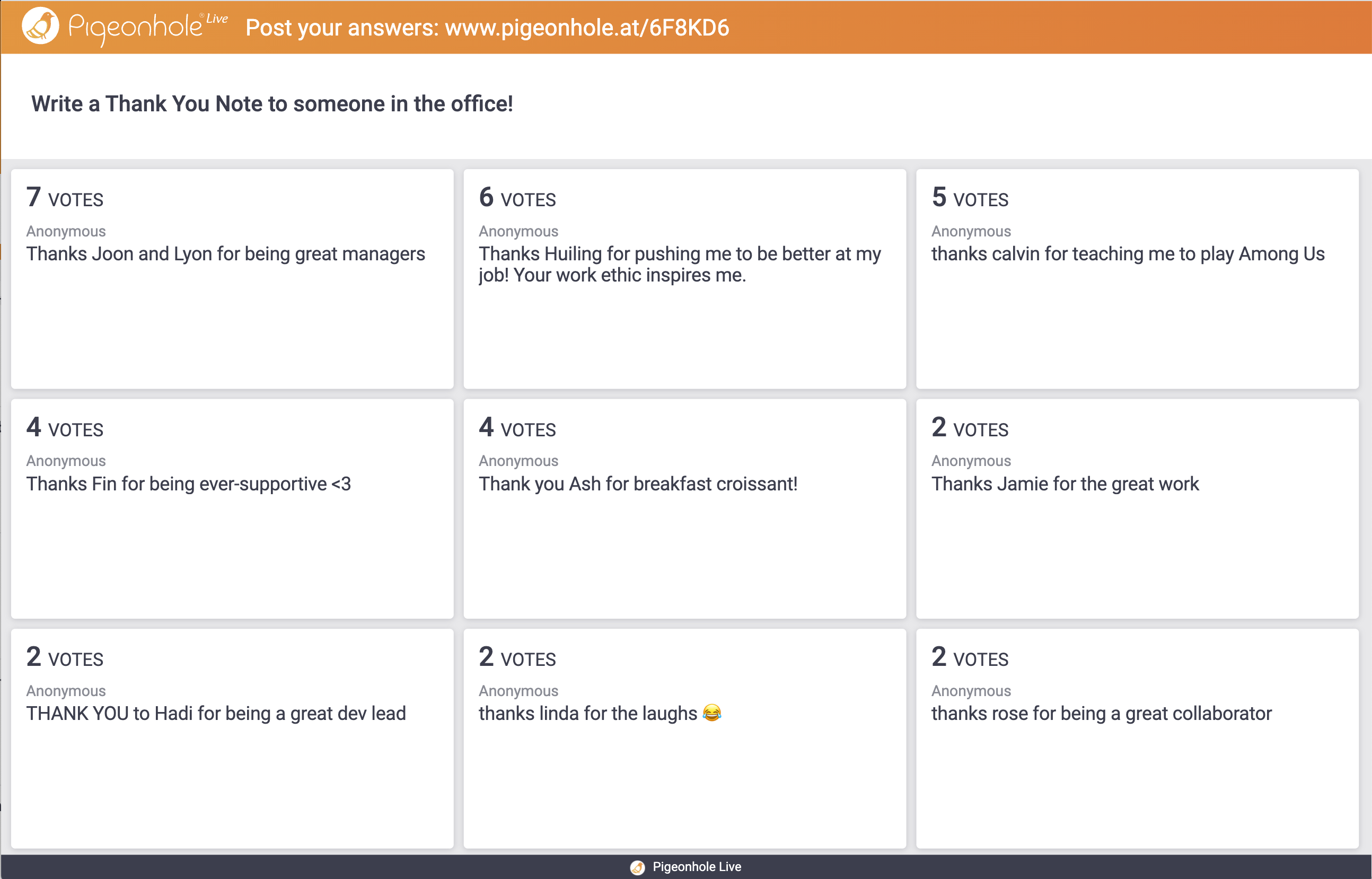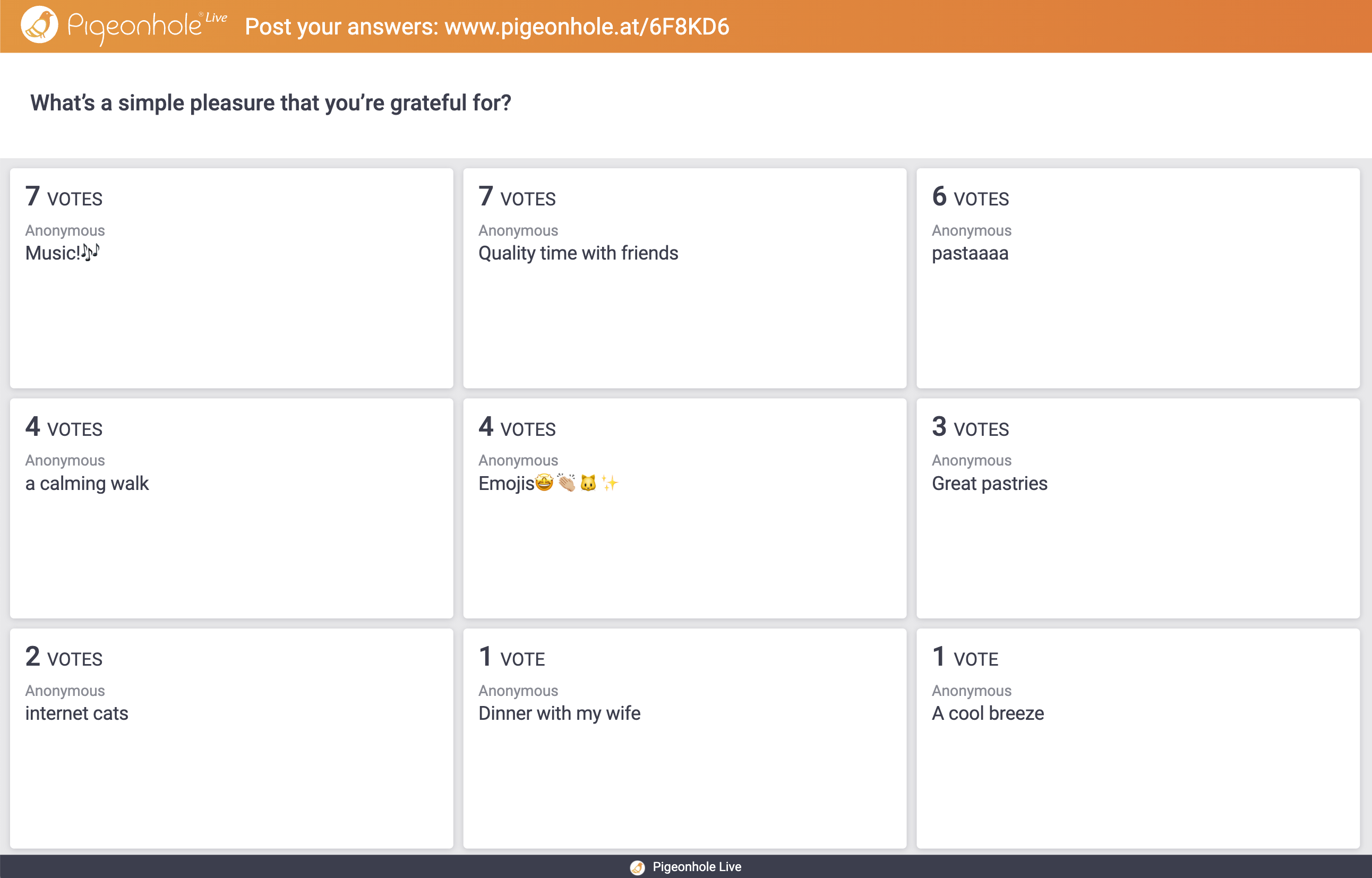How to Create a Gratitude Culture in the Workplace

Annie Teh
April 5, 2023

Table of Contents
As we navigate through the demands and challenges of an ever-changing workplace, it's easy to lose sight of what truly matters. Amidst deadlines, meetings, and presentations, we often forget the power of gratitude — the simple act of expressing appreciation for the good things in our lives.
What if we could harness this power to create a more positive and fulfilling work environment? In this article, we'll explore how you can cultivate a culture of gratitude in the workplace, discover the benefits it can bring to you and your team, and share two strategies you can use now:
- How to practice gratitude at work in 7 ways
- How to cultivate a culture of gratitude with Pigeonhole Live
What makes gratitude so important?
Expressing gratitude in the workplace has many benefits including reducing sick days, lowering work stress, and increasing job satisfaction. It also positively affects individuals by improving personal relationships, physical health, and sleep quality.
On the other hand, a survey revealed that 46% of respondents have quit a job due to feeling unappreciated, while 65% expressed that they would have worked harder if they felt their contributions were recognized by management.
Despite all the benefits it gives, it can be awkward to show gratitude. This is especially true when either the company or country’s culture is not used to public shows of gratefulness. If your company struggles with the phrase “thank you”, doing gratitude exercises may be awkward, uncomfortable, or even frustrating.
To help enjoy the benefits that gratitude can bring to the company, consider creating avenues or events to show gratitude. Even if the occasion feels orchestrated, genuine gratitude can still be conveyed and felt. If you're looking to create a culture of gratitude in your workplace, here are some tips and exercises to get you started.
7 tips for practicing gratitude at work
Creating a positive work environment is essential for employee satisfaction. Cultivating a culture of gratitude is one way to achieve this. In this section, we'll explore seven tips for practicing workplace gratitude and improving engagement and productivity. Managers leading by example can have a significant impact on the team!
1. Express appreciation verbally
One of the easiest is to just say "thank you" or "good job" to your colleagues and employees. It might not seem like much, but a simple expression of appreciation can go a long way in boosting morale and creating a positive work environment. Here are some examples:
- "Thanks for your hard work on that project. Your contribution really made a difference."
- "Great job on that presentation! I understand the project goals a lot better now."
- "I just wanted to say thanks for staying late to help me finish that task."
2. Write thank-you notes
Handwritten notes expressing gratitude can have a significant impact on colleagues or employees who did a good job or were particularly helpful. For instance, Douglas Conant, the former CEO of Campbell Soup Company, famously gave out 30,000 handwritten notes to his employees, writing up to 20 notes a day!
3. Give public recognition
Publicly recognizing colleagues for their hard work is a powerful way to show gratitude. This can be done through awards or company-wide announcements. Don't forget about the people working behind the scenes, as they often get less credit. Take time to reflect and thank them for their hard work too.
For example, a monthly "employee of the month" program is one common way to publicly recognize contributions. A different employee can be celebrated each month for their hard work and achievements, and a small prize or reward can be given, such as a gift card or company-sponsored lunch.
4. Create a culture of gratitude
Encourage a culture of gratitude by regularly highlighting the achievements and contributions of colleagues and employees. This can be done through team meetings, newsletters, or other communication channels.
Remember to tailor gratitude to the culture you are in, especially for diverse and international teams. In China, for instance, connective gratitude such as offering help or friendship is preferred, while Americans prefer verbal gratitude through expressions of thanks or compliments.
When you are unsure how to express gratitude in a way that is meaningful to your team, try asking them directly: "How would you show gratitude?" This simple question can open up a productive discussion and demonstrate that you value their input. Plus, you may discover some unique ideas that you hadn't considered before!
- "To show my gratitude, I'd take the person out for coffee or lunch. This way, we could have a chance to connect personally and show appreciation face-to-face."
- "I'd learn their interests and give a personalized gift reflecting their personality, like a bonsai plant for their desk if they love gardening."
- "I would write a thoughtful and specific LinkedIn recommendation for the person to publicly acknowledge their contributions and accomplishments."
5. Give back to the community
One way to demonstrate gratitude and give back to the community is by organizing charitable events or volunteer days. This can involve partnering with local charities or non-profit organizations and encouraging employees to participate in community service projects.
If your company values environmental sustainability, for example, you could organize a local beach clean-up day. Cleanups can have a significant impact by removing harmful waste and restoring marine habitats. Plus, proper disposal of trash reduces the risk of animals ingesting it, minimizing the danger to their well-being.
6. Encourage self-reflection
Self-reflection is a powerful way to cultivate gratitude in the workplace. By encouraging colleagues and employees to reflect on what they are grateful for in their personal and professional lives, you can help them focus on the positive parts of their work and gain a deeper appreciation for the things they often take for granted.
One effective way to encourage self-reflection is through gratitude journaling, where employees write down things they are thankful for every day. Another way is through self-reflection exercises, such as taking time to meditate or simply pause and reflect on their day.
If employees are not used to journaling, create a 'gratitude board' where people write down something they're grateful for on a Post-it note daily. The board can be placed in a common area and employees can take turns reading the daily gratitude statements. This promotes a positive and grateful mindset among team members.
7. Foster a positive work environment
Creating a positive work environment requires valuing and encouraging employees, which can have a positive impact on their mental health and well-being as well. Here are some ways to practice it:
Regular check-ins. One-on-one meetings every week or two can provide a platform for discussing progress, challenges, and goals, as well as feedback and input on company decisions. This fosters a culture of open communication and collaboration that helps everyone succeed.
Training & growth opportunities. Offering growth and development opportunities can make employees feel valued. A "lunch and learn" series with industry experts or leaders is an excellent way to achieve this. Employees can learn, expand their skill set, and feel supported by their company while enjoying a meal at the same time!
Encouraging communication. Open communication boosts job satisfaction and creates a positive work environment. Holding regular town hall meetings, for example, allows employees to share feedback effectively, promoting a culture of open communication and enhancing their job satisfaction.
3 gratitude exercises you can try with Pigeonhole Live
Pigeonhole Live fosters a gratitude culture in the workplace by enabling employees to appreciate and recognize their colleagues. With live polls, Q&A sessions, and surveys, employees can express their thanks and appreciation for each other's contributions, improving well-being, morale, and job satisfaction.
Here are some exercises to help express gratitude at work and improve communication, especially for remote or international teams. These exercises can facilitate meaningful discussions and provide an online platform for employees to share their thoughts and opinions.
1. Gratitude Word Cloud
To promote gratitude in a bigger-picture exercise, creating a visually-impactful word cloud with many things to be thankful for can be a great idea. This exercise can also extend beyond the workplace, allowing for a heart-warming sharing session that can motivate and energize teams.

To make this exercise even more effective, simplicity is key. Keeping answers to a few words or even emojis can make the generated word cloud stand out and enhance the impact of the exercise.
Try these simple prompts:
- What are you thankful for today?
- Who do you appreciate in your life?
- What food brings you joy?
- Which place are you grateful for?
2. Thank You Note Board
Use an open-ended poll as a digital note board to crowdsource statements of gratitude for colleagues who have done something special. This could be for simple tasks like making coffee for colleagues or having a positive attitude. Allow anonymous entries to encourage shy employees to express their gratitude.
 This is also a great opportunity to thank the people that don’t get much credit in day-to-day tasks, so take the opportunity to write thankful notes for them!
This is also a great opportunity to thank the people that don’t get much credit in day-to-day tasks, so take the opportunity to write thankful notes for them!
3. Gratitude Prompts
In a professional setting, expressing gratitude can be challenging for some employees who may feel uncomfortable or unsure of how to express their feelings. When gratitude feels awkward, providing guidance and prompts can help employees to express their appreciation in a comfortable and supported way.

Guiding employees with helpful prompts can ease the expression of gratitude. Allowing anonymous entries also helps those hesitant to share openly feel more comfortable. To do this, simply create an open-ended poll in Pigeonhole Live and use prompts such as:
- What are you looking forward to with excitement?
- What is a small joy that you appreciate?
- What is an indulgence that you enjoy despite feeling guilty?
- What brings you the most gratitude during a tough day?
- What aspects of the workplace are you grateful for?
- What talents or abilities do you feel grateful to have?
Use these at the beginning of the week or as an ice breaker for meetings to set a positive tone for the work week ahead.
Begin cultivating a culture of gratitude today
Gratitude is a powerful tool that can transform the culture of a workplace. By taking small steps like expressing appreciation and providing opportunities for recognition, you can create a positive environment that benefits everyone. By fostering a gratitude culture, you can improve employee engagement, reduce turnover, and boost productivity. Start today by taking the first step towards a more grateful workplace!
Try out gratitude exercises with Pigeonhole Live
| Note: This article was first published in 2020 and has been subsequently updated with new insights and statistics. |
Download our ebook to uncover more ways to apply the two-way conversation approach in your town halls.

